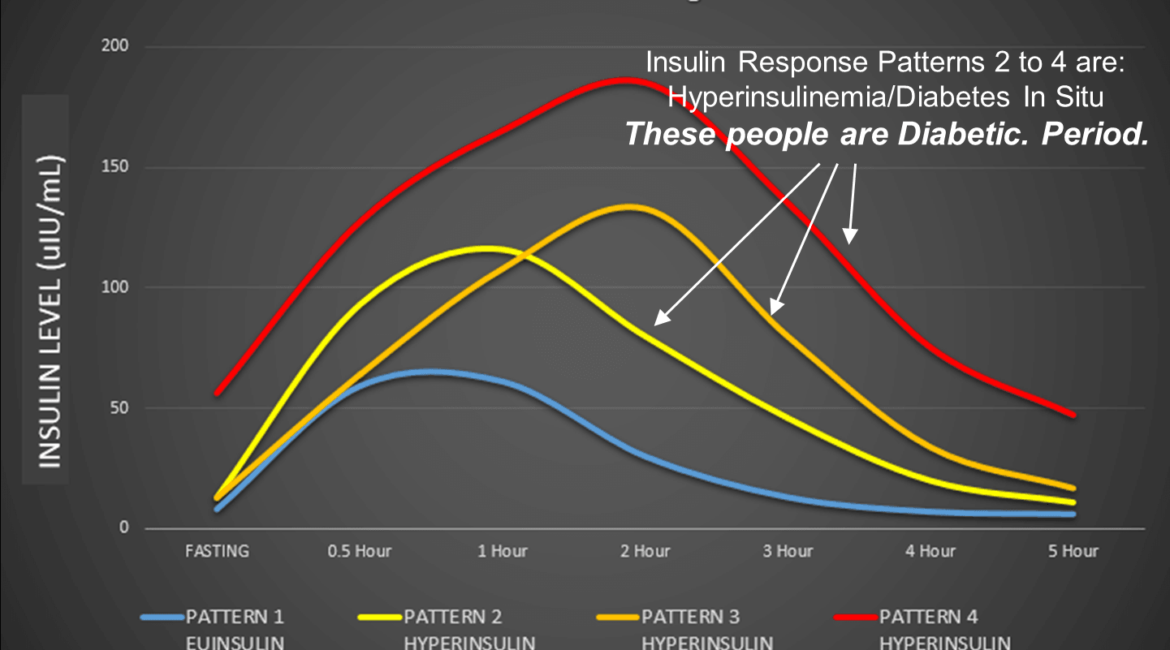Disclaimer: This is not for Type 1 or Type 2 diabetics on Insulin.
Low-carb diet for managing diabetes, obesity, insulin resistance, pcos, NAFLD etc is all about cutting down carbohydrates and replacing them with healthy fats and proteins. The entire low-carb arena is broadly classified into LCHF and Ketogenic diet as far as we on dLife.in are concerned. We do not use the two terms interchangeably. More on this topic covered in this piece.
Curves 2 through 4 in the image above are typical in case of diabetics. Which one fits your case would depend on your diabetes history and diet. Conventional diabetes management never believes in looking at these curves. They just stick to nonsensical high carb low fat diet which is then covered with drugs (to reduce insulin resistance) and/or to push the production of endogenous insulin up or in extreme cases inject insulin.
The whole idea of the LCHF diet in different shades is to push curves 2 through 4 to curve 1 as far as possible because hyperinsulinemia is not the ideal situation to live with. I mentioned “different shades” because every diabetic will have different per meal carb tolerance levels. In any case, we do restrict carb intake to 20% max of daily calorie needs.
Per Meal Carb Tolerance – How To Check?
This question often gets asked: “How do I test my per meal carb tolerance?. Logically, this can be checked through two methods — testing blood glucose or blood glucose & insulin. However, insulin testing will require drawing blood samples in the lab for tests. Blood sugar can easily be tested using a glucometer at home. We will therefore focus on testing blood glucose levels only. Before this, please check this piece on what values of blood sugar we aim for, even as a diabetic.
Also, please note that the peaks with Glucose as intake hits at around 60 minutes. So, we will be testing the 1 hr and 2 hr values.
The Easier method
The testing starts with 10g pure glucose and we terminate with 30g glucose because in any case, we aim to keep the total carbs intake to 100g/day as a maximum.
Day 1:
- Measure FBS.
- Take 10 gram glucose and sit idle. No exercise, no moving around.
- No pancreas whipping drugs, DPP4i or SGLt2i to be taken.
- Measure 1 hr and 2 hr readings.
- If the 1 and 2hr readings are within 140 max and 120 max, respectively, then move to Day 2. Else, your carb limit per meal is 10 gm.
Day 2:
- Measure FBS.
- Take 20 gram glucose and sit idle. No exercise, no moving around.
- No pancreas whipping drugs, DPP4i or SGLt2i to be taken.
- Measure 1 hr and 2 hr readings
- If the 1 and 2hr readings are within 140 max and 120 max, respectively, then move to Day 3. Else, your carb limit per meal is 20 gm.
Day 3:
- Measure FBS.
- Take 30 gram glucose and sit idle. No exercise, no moving around.
- No pancreas whipping drugs, DPP4i or SGLt2i to be taken.
- Measure 1 hr and 2 hr readings
- If the 1 hr and 2 hr readings are within 140 max and 120 max, respectively, your per meal carb limit is 30 gm.
Getting to Test Insulin Levels
After having fixed your per meal tolerance, the next step would be to see where your insulin levels land. Here, depending on your per meal carb tolerance, you can have meals having that much carbs safely. And, you can move around post meals as usual. A large number of LCHF / Keto recipes have been posted with proximates already computed. You can select any recipe from this for your tests.
- Draw sample for FBS and fasting insulin by the lab and also test on the meter at the same time.
- Have your meal and draw 2 hr sample for the blood test and insulin test. Also, measure 1 hr and 2 hr blood sugar values by the meter.
- Check where your insulin levels are in the chart as shown in the image above. Ideally fasting insulin should be in the 3 to 6 range. On the LCHF diet, it is easily possible to hit that range over a period of time. Do note the disclaimer at the start of this piece.
What if the Blood Sugar is fine but Insulin Levels higher?
The simplest solution is to incorporate some movement/exercise, around 40 min after the first bite to help in non-insulin mediated glucose uptake. Get your eyes checked for retinopathy before taking up strength-building exercises. Easiest is walking or climbing stairs.
Additionally, if you have weight to lose, then please note that losing weight will also help in reducing insulin resistance. Hyperinsulinemia is a strong sign of insulin resistance. Tweak your diet and lifestyle so that you hit fasting insulin levels ranging from 3 to 6. Laboratory range of up to 25 marked as normal is criminally wide.
If you do these experiments, please do not forget to share on the forum in the Exercise, Experiments, Other Diets & Supplements section.
Here are my own blood sugar readings checked randomly and I keep updating the same thread on Twitter, besides updating the following thread on the forum:
Anup Singh’s Blood Sugar Readings
And here is my data for experimental run with 30 grams and 50 grams glucose
| Glucose | Base Reading | One Hour | Two Hour |
|---|---|---|---|
| 30 gram glucose | 118 mg/dL | 131 mg/dL | 79 mg/dL |
| 50 gram glucose | 94 mg/dL | 158 mg/dL | 120 mg/dL |
Based on this, I would peg my per meal tolerance of carbs at 30 grams. This is after being a Type 2 diabetic on LCHF diet for 8+ years and zero medicines.




